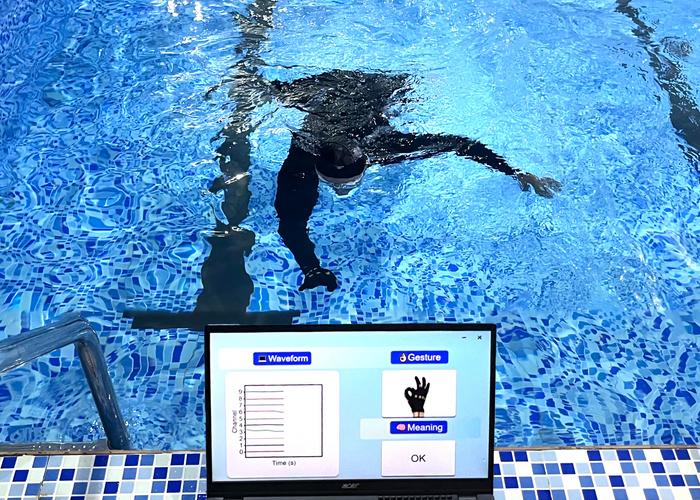Scuba divers often use hand signals to communicate with their dive partners, but these movements can be difficult to see in the underwater environment. Now, researchers have developed a waterproof “e-glove” that wirelessly transmits hand gestures made underwater to a computer, which translates them into messages. This new technology, reported in ACS Nano, could revolutionize the way divers communicate with each other and with boat crews on the surface.
E-gloves are gloves fitted with electronic sensors that translate hand motions into information. While they are already being developed for various applications, such as interacting with virtual reality environments or helping stroke patients regain fine motor skills, creating a waterproof version for use in a swimming pool or the ocean is a significant challenge. The researchers, led by Fuxing Chen, Lijun Qu, and Mingwei Tian, set out to create an e-glove capable of sensing hand motions when submerged underwater.
The team began by fabricating waterproof sensors inspired by the tube-like feet of a starfish. Using laser writing tools, they created an array of flexible microscopic pillars on a thin film of polydimethylsiloxane (PDMS), a waterproof plastic commonly used in contact lenses. They coated the PDMS array with a conductive layer of silver and sandwiched two of the films together with the pillars facing inward to create a waterproof sensor. The sensor, roughly the size of a USB-C port, is responsive when flexed and can detect a range of pressures comparable to the light touch of a dollar bill up to the impact of water streaming from a garden hose.
The researchers packaged 10 of these waterproof sensors within self-adhesive bandages and sewed them over the knuckles and first finger joints of their e-glove prototype. To create a hand-gesture vocabulary for the demonstration, a participant wearing the e-glove made 16 gestures, including “OK” and “Exit.” The researchers recorded the specific electronic signals generated by the e-glove sensors for each corresponding gesture and applied a machine learning technique for translating sign language into words to create a computer program that could translate the e-glove gestures into messages.
When tested, the program translated hand gestures made on land and underwater with an impressive 99.8% accuracy. The team believes that a version of this e-glove could help scuba divers communicate with visual hand signals even when they cannot clearly see their dive partners.
The development of this waterproof e-glove is a significant step forward in improving communication for scuba divers. By translating hand gestures into messages, divers can more effectively convey important information to their partners and boat crews, enhancing safety and coordination during underwater activities.
The researchers acknowledge funding from various sources, including the Shiyanjia Lab, National Key Research and Development Program, Taishan Scholar Program of Shandong Province in China, Shandong Province Key Research and Development Plan, Shandong Provincial Universities Youth Innovation Technology Plan Team, National Natural Science Foundation of China, Natural Science Foundation of Shandong Province of China, Shandong Province Science and Technology Small and Medium sized Enterprise Innovation Ability Enhancement Project, Natural Science Foundation of Qingdao, Qingdao Key Technology Research and Industrialization Demonstration Projects, Qingdao Shinan District Science and Technology Plan Project, and Suqian Key Research and Development Plan.
As this technology continues to advance, it may find applications beyond scuba diving, such as in other underwater professions or even in space exploration. The waterproof e-glove represents an exciting new frontier in wearable technology and communication, with the potential to improve safety and efficiency in a variety of challenging environments.


